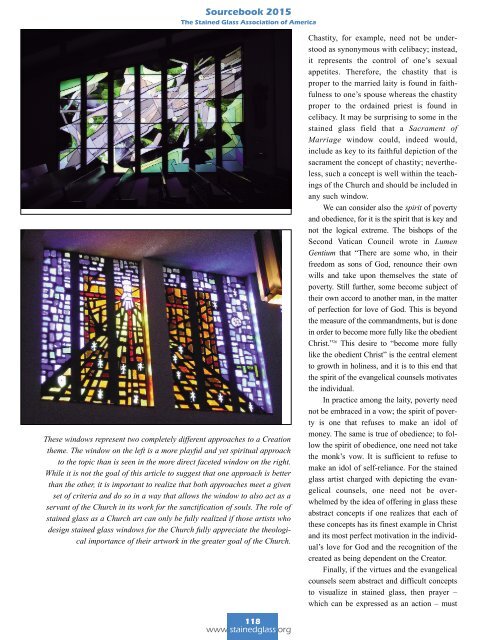Sourcebook 2015
Sourcebook-2015OE
Sourcebook-2015OE
- No tags were found...
You also want an ePaper? Increase the reach of your titles
YUMPU automatically turns print PDFs into web optimized ePapers that Google loves.
<strong>Sourcebook</strong> <strong>2015</strong><br />
The Stained Glass Association of America<br />
These windows represent two completely different approaches to a Creation<br />
theme. The window on the left is a more playful and yet spiritual approach<br />
to the topic than is seen in the more direct faceted window on the right.<br />
While it is not the goal of this article to suggest that one approach is better<br />
than the other, it is important to realize that both approaches meet a given<br />
set of criteria and do so in a way that allows the window to also act as a<br />
servant of the Church in its work for the sanctification of souls. The role of<br />
stained glass as a Church art can only be fully realized if those artists who<br />
design stained glass windows for the Church fully appreciate the theological<br />
importance of their artwork in the greater goal of the Church.<br />
Chastity, for example, need not be understood<br />
as synonymous with celibacy; instead,<br />
it represents the control of one’s sexual<br />
appetites. Therefore, the chastity that is<br />
proper to the married laity is found in faithfulness<br />
to one’s spouse whereas the chastity<br />
proper to the ordained priest is found in<br />
celibacy. It may be surprising to some in the<br />
stained glass field that a Sacrament of<br />
Marriage window could, indeed would,<br />
include as key to its faithful depiction of the<br />
sacrament the concept of chastity; nevertheless,<br />
such a concept is well within the teachings<br />
of the Church and should be included in<br />
any such window.<br />
We can consider also the spirit of poverty<br />
and obedience, for it is the spirit that is key and<br />
not the logical extreme. The bishops of the<br />
Second Vatican Council wrote in Lumen<br />
Gentium that “There are some who, in their<br />
freedom as sons of God, renounce their own<br />
wills and take upon themselves the state of<br />
poverty. Still further, some become subject of<br />
their own accord to another man, in the matter<br />
of perfection for love of God. This is beyond<br />
the measure of the commandments, but is done<br />
in order to become more fully like the obedient<br />
Christ.” 26 This desire to “become more fully<br />
like the obedient Christ” is the central element<br />
to growth in holiness, and it is to this end that<br />
the spirit of the evangelical counsels motivates<br />
the individual.<br />
In practice among the laity, poverty need<br />
not be embraced in a vow; the spirit of poverty<br />
is one that refuses to make an idol of<br />
money. The same is true of obedience; to follow<br />
the spirit of obedience, one need not take<br />
the monk’s vow. It is sufficient to refuse to<br />
make an idol of self-reliance. For the stained<br />
glass artist charged with depicting the evangelical<br />
counsels, one need not be overwhelmed<br />
by the idea of offering in glass these<br />
abstract concepts if one realizes that each of<br />
these concepts has its finest example in Christ<br />
and its most perfect motivation in the individual’s<br />
love for God and the recognition of the<br />
created as being dependent on the Creator.<br />
Finally, if the virtues and the evangelical<br />
counsels seem abstract and difficult concepts<br />
to visualize in stained glass, then prayer –<br />
which can be expressed as an action – must<br />
118<br />
www.stainedglass.org


